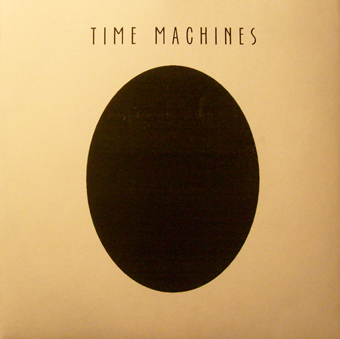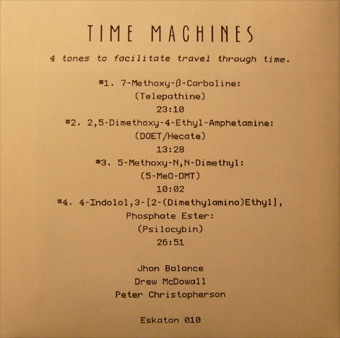| |
Some notable drone music
examples include, chronologically:
source
wikipedia
-
La Monte Young's 1960s drone-based pieces, solo and with
John
Cale,
Tony Conrad,
Marian Zazeela,
Terry Riley,
Angus MacLise,
Terry Jennings and/or
Billy Name in the
Theater of Eternal Music (aka The Dream Syndicate). Young has
claimed that his 1958 "Trio for Strings" is the first piece to have ever
been created using nothing but long, sustained sounds.
-
Giacinto Scelsi's 1959 piece Quattro Pezzi Su Una Nota Sola
for one pitch and numerous subsequent pieces by himself and his
followers and contemporaries in the realm of
spectral composition, including
Iannis Xenakis whose earlier 1958 "Concrete Ph" is a tape work of
superimposed recordings of smoldering charcoal which form a near-static
field of sound, while not a strictly "drone" work operates with a
similarly minimal-souce and stilled-time sensibility, as well as
Romanian composer
Iancu Dumitrescu and many others.
-
Yves Klein's 1961 performance art piece, The Monotone Symphony,
which included an unvarying 20-minute drone as its first movement.
-
Late 1960s - 1980s work
by minimal composers and gallery artists
Yoshimasa Wada (The Rise and Fall of the Elephantine Serpentine),
Tony Conrad and Faust (Outside the Dream Sydicate),
Terry
Fox (Berlino),
Harry Bertoia,
Jon
Gibson (Two Solo Pieces),
Charlemagne Palestine (Four Manifestations on Six Elements),
David Hykes (Hearing Solar Winds),
Pauline Oliveros (Horse Sings From Cloud),
Alvin Lucier (Music on a Long, Thin Wire),
Harley Gaber (The Wind Rises in the North),
Stuart Dempster (In the Great Abbey of Clement VI), and
Remko Scha (Machine Guitars), to name only a few. All used
long, sustained and timbrally dense harmonic material for the entirety
of various of their pieces.
-
Kraftwerk's experimental/drone self-titled first album
Kraftwerk (1970): the 4-minute intro to "Stratovarius", the
organ drone on most of "Megaherz", the first half of "Vom Himmel Hoch".
-
Klaus Schulze's early "organ drone" albums Irrlicht (1972),
and Cyborg (1973).
-
Tangerine Dream's ambient drone album
Zeit
(1972), and to a lesser degree
Phaedra (1974).
-
Fripp and
Eno:
the 21-minute drone ambient of "The Heavenly Music Corporation" on
No Pussyfooting (1973), the 28-minute drone ambient of "An Index
of Metals" on
Evening Star (1975).
-
Jon Hassell's Vernal
Equinox (1977)
-
On
Miles Davis' Agharta (1975): the last 6 minutes of the last
track, especially the last 2 minutes.
-
Coil's drone music albums such as
How to Destroy Angels EP (1984) and LP (1992),
Time Machines (1998), or
ANS
(2003). Plus many tracks on non-drone albums, such as "Tenderness of
Wolves" on
Scatology (1984), "Wrim Wram Wrom" on
Stolen and Contaminated Songs (1992), "Cold Dream Of An Earth
Star" and "Die Wolfe Kommen Zuruck" on Black Light District: A
Thousand Lights In A Darkened Room (1996), "North" on Moon's Milk
(1998). (Plus many semi-drone tracks such as "Her Friends The Wolves...",
"Moon's Milk Or Under An Unquiet Skull Part 1", "Bee Stings", "Refusal
Of Leave To Land", "Magnetic North", etc.)
-
On
Aphex Twin's
Selected Ambient Works Volume II (1994): especially "[spots]"
and "[tassels]", and to a lesser degree tracks such as "[tree]",
"[parallel stripes]", "[grey stripe]", and "[white blur 2]".
-
Bowery Electric's "Postscript" on the album Beat (1996).
-
Gescom
(a side-project of
Autechre): the experimental album Minidisc (1998) is half
drone ambient (tracks "Cranusberg [1-3]", "Fully [1-2]", "Shoegazer", "Polarized
Beam Splitter [1-5]", "Dan Dan Dan [1-4]", "A Newer Beginning [1-2]",
"Go On", and to a lesser degree "Interchangeable World [1-3]", "Yo! DMX
Crew", "New Contact Lense", "1D Shapethrower", "Inter", "Of Our Time",
or the drone techno of "Pricks [1-4]").
-
Radiohead's "Treefingers" on the album
Kid A
(2000)
-
Biosphere : half of his ambient/drone album Shenzhou (2002),
and his drone album Autour de la Lune (2004).
-
Boards of Canada : the drone ambient of "Corsair" on
Geogaddi (2002).
-
Melthair and the
Loverats debut album "Sex Wrangler" contains numerous drones (www.myspace.com/melthairandtheloverats)
-
Wilco's
album
A Ghost Is Born (2004) contains "Less
Than You Think", a 15-minute-long track containing ~12 minutes of
droning ambience after a brief piano-based melody.
-
contemporary drone
composers
Phill Niblock,
Jliat,
Ian Nagoski,
Leif Elggren,
Eliane Radigue, etc.
-
Dark Ambient,
Noise Music, post-Industrial
Music and
Improvised Music bands and projects involved with drone music
include
Autopsia,
Die
Krupps,
KK Null,
Pelt,
Zoviet France,
Hototogisu,
Double Leopards,
C.C.C.C.,
Merzbow,
Trockeneis.
-
Other contemporary
bands representative of this genre include
Maeror Tri,
Stars of the Lid,
Children of the Drone,
Windy & Carl,
Troum,
House of Low Culture,
Growing,
Cisfinitum,
Klood,
Melek-Tha,
Raagnagrok,
Alp,
Controlled Bleeding, and
Laminar. Some important hearths for bands in the genre include
Soleilmoon or
Drone Records.
-
"National Grid" by art
/ noise group Disinformation (see
Disinformation (band)) uses pitch-shifting electric guitar pedals to
introduce subharmonic intermodulation patterns in amplified live mains
electricity (sourced using VLF radio interference and/or direct output
from live mains transformers), to produce intense and highly immersive
sub-bass performances and sound installations. "National Grid"
performances have taken place at
ZKM
(Karlsruhe) and the
Volksbuhne (Berlin), in the UK at
The Royal Institution, Disobey, Corsica Studios,
The Royal College of Art, Westbourne Studios, Cargo (all London) and
The Junction (Cambridge). "National Grid" installations have been
exhibited in the access corridor of a underground nuclear warfare
command centre, the engine room of an arctic trawler, and at The Foundry,
Kettle's Yard and
Fabrica
galleries, with the longest running version of this drone composition
lasting continuously for 6 weeks. "National Grid" was first published by
Ash International on LP in 1996 and on CD in 1997, and also appears
on the "New Forms" 2xCD, published by Galerie für zeitgenössische Kunst
(Leipzig) curated by Carsten Nicolai, and on The Hayward Gallery
(London) "Sonic Boom" exhibition catalogue 2xCD curated by
David Toop.
-
"The Barometric Sea" by
Deepspace is drone-based, taking in many ambient and drone
influences.
-
Most of
Bethany Curve's songs are drone-based, made only with guitars.
|
|
|
|
|



